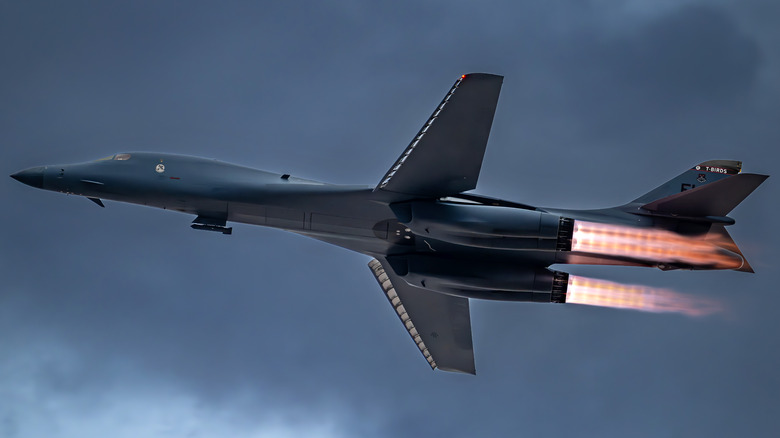The USAF Is Still Flying The B-1 Lancer 40 Years After Its Introduction: Here's Why
The United States Air Force has employed many types of bombers since it split off from the Army in 1947. While many outside the military know about bombers like the B-2 Spirit, that's only one of three aircraft that are the Air Force's strategic bombers. The other two are the B-52 Stratofortress and the B-1 Lancer, known within the service as the "Bone."
The B-1 has been around since 1985, making it the second-oldest strategic bomber after the B-52. There are many reasons why the Air Force continues to fly such ancient aircraft, but above all, they're reliable, incredibly useful, and almost impossible to locate and shoot down. That said, the B-1 has no stealth capabilities, but it has something else that keeps it active — a massive payload capacity of 75,000 pounds. Of the three strategic bombers currently operated by the United States, the B-1 can carry the largest payload.
That alone makes the B-1 Lancer one of the most effective and mission-capable aircraft in the Air Force's inventory. But there's more that keeps this decades-old aircraft flying the unfriendly skies across the globe. While the Air Force is in the process of retiring its B-1s, along with the B-2s and B-52s – replacing all three with Northrop Grumman's B-21 Raider – that process won't finish for a number of years, perhaps as late as 2040. That will leave the B-1 Lancer a major player in strategic and tactical bombing operations well into the future.
The B-1B Lancer is fast and versatile
The B-1's development began in the 1970s as an intended replacement for the aging B-52. Before it could be introduced, a variant model, the B-1B Lancer, was produced in 1981, improving the original design to increase its payload, improve its radar system, and reduce its radar signature. The last B-1B entered the Air Force's inventory in May of 1988, and they've remained in service ever since. Before production ended, 100 B-1B Lancers were delivered. Fewer than half remain in active service.
The B-1B is an incredibly versatile aircraft capable of flying up to 1.2 times the speed of sound (920.7 mph) at sea level. Its ceiling is 30,000-plus feet, it carries over 265,000 pounds of fuel, and has a range of 7,455 miles, which can be increased to an unlimited range with aerial refueling. Its speed is accomplished via the aircraft's four General Electric Aviation F101-GE-102 turbofan engines, each capable of delivering 30,780 pounds of thrust for a combined total of 123,120.
The aircraft is large, measuring 146 feet long and 34 feet high, and its forward sweeping wingspan is 137 feet, while the aft sweeping wing is 79 feet. The B-1B is operated by a pilot, co-pilot, and two combat systems officers, one of whom operates offensive weaponry while the other manages the aircraft's defensive weapons. While the B-1 can carry 75,000 pounds of payload and another 265,000 pounds of fuel, its total maximum takeoff weight is an immense 477,000 pounds.
The B-1B Lancer's ordnance carrying capability
The B-1B Lancer's payload can accommodate a large variety of bombs to drop on targets. Depending on mission requirements, a B-1 can carry the following configurations: 84 MK-82 500-pound or 24 MK-84 2,000-pound bombs; 84 MK-62 500-pound or eight MK-65 2,000-pound Quickstrike naval mines; 30 CBU-87/89 cluster bombs or 30 CBU-103/104/105 Wind Corrected Munitions Dispensers; 24 GBU-31 or 15 GBU-38 Joint Directed Attack Munitions/GBU-54 JDAM; 24 AGM-158A Joint Air-to-Surface Standoff Missiles, JASSM-Extended Range Missiles, or Long-Range Anti-Ship Missiles.
While that's a lot of conventional bombs, that's not what the B-1 was initially designed to drop. When it was first produced, the B-1 was meant as a nuclear strategic bomber. But it can no longer carry nuclear arms. After the fall of the Soviet Union, the U.S. entered into the START I treaty with Russia, which required a significant modifications to the United States' strategic bombers, including the B-1. A refit removed the structures and arming mechanisms needed to carry gthe B-1's nukes.
The Russians retain the right to inspect the aircraft to ensure this remains true, but it isn't something that can be easily undone, as the last refit was completed in 2011 and the B-1 is slated for retirement. The B-1 won't be a part of the U.S.'s nuclear triad of strategic defense when that happens, but for now it's an incredibly capable and reliable bomber.


